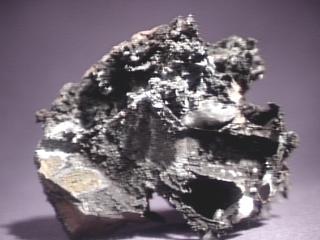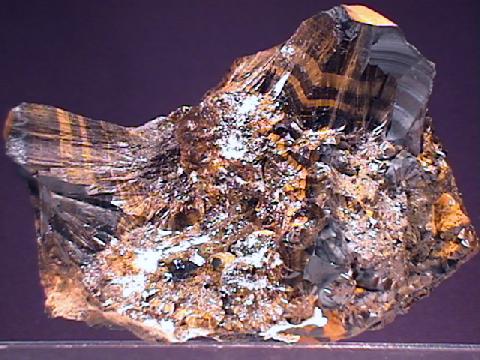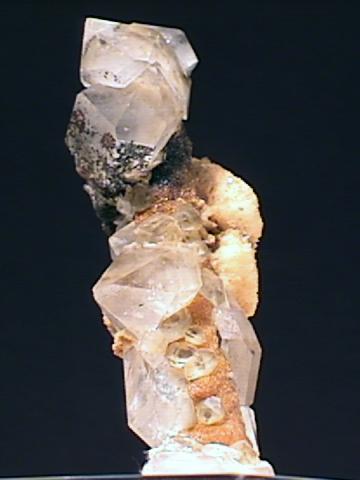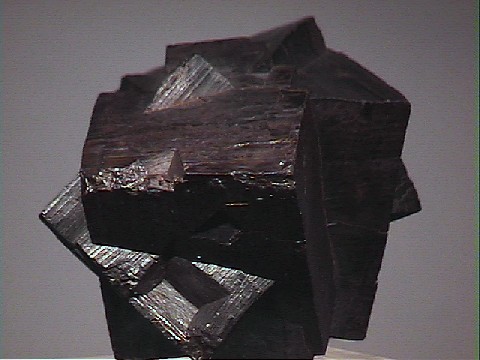 The Mineral GOETHITE
The Mineral GOETHITE
- Chemical Formula: FeO(OH), Hydrated Iron Oxide
- Class: Oxides and Hydroxides
- Group:
Goethite - Uses: important ore of iron, pigment
Specimens
PHYSICAL CHARACTERISTICS:
- Color is yellow, brown, brownish red to black. Sometimes tarnished with irridescent colors.
- Luster is earthy to dull for massive forms and metallic for crystals.
- Transparency crystals are opaque.
- Crystal System is orthorhombic; 2/m 2/m 2/m
- Crystal Habits include prismatic and platy crystals, massive and aggregate forms include internally radiating or fibrous; reniform, botryoidal and stalactitic.
- Cleavage is perfect in one direction.
- Fracture is uneven to splintery.
- Hardness is 5-5.5
- Specific Gravity is variable at 3.3 to 4.3 (light for metallic minerals)
- Streak is brown, brownish yellow to orange yellow.
- Associated Minerals include a large list of minerals (particularly secondary deposit minerals).
- Notable Occurences include many iron mines around the world; especially nice specimens come from England, Mexico, and the Lake Superior region in Michigan, USA.
- Best Field Indicators are crystal habit, streak and tarnish.
 Amethyst Galleries' Mineral Gallery MINERALS |

GOETHITE specimen goe-2
$ 35.00
$ 35.00
Dims: 2-3/4" x 2-7/8" x 2-1/2"
Wt: 6 oz
Chihuahua area, Mexico
Almost dendritic, treelike formations coming off the piece in opposing directions along one plane distinguish this Goethite specimen. There are several hollow areas, and one or two smooth edges that signify the former presence of long, prismatic selenite crystals. There are actually several clusters of minute bladed selenites still on the specimen, and I believe that they formed after the Goethite. One really must see this specimen to appreciate it

goe-2 ($ 35.00)
Chihuahua area, Mexico

GOETHITE specimen goe-3
$ 30.00
$ 30.00
Dims: 2-3/4" x 1-7/8" x 2-1/2"
Wt: 15.1 g
Lake George, Park Co., Colorado, U.S.A.
This thumbnail specimen has no host rock or matrix-- it is made up entirely of Goethite. It is fibrous and radial, with hundreds of almost microscopic crystals, and some sprays of thin blades that are close to 1/2" long. Its color is black to brown, with an almost metallic luster. There is little damage to the exposed clusters, except where the specimen was separated from its birthplace.


goe-3 ($ 30.00)
Lake George, Park Co., Colorado, U.S.A.

GOETHITE specimen goe-4
$ 18.00
$ 18.00
Dims: 3" x 1-1/4" x 3/4"
Wt: 1.6 oz. w/ base
Chihuahua area, Mexico
This lovely Goethite specimen comes in the form of a stalactite, with botryoidal formations that make it look like "frozen smoke". Its color is black, with some portions of it looking a rusty brown color from a dusting of limonite. It has a matte luster with no detectable crystal faces and almost no visible damage. It has been affixed to a 2" square acrylic base with a hot-melt glue.

goe-4 ($ 18.00)
Chihuahua area, Mexico

GOETHITE specimen goe-5
$ 18.00
$ 18.00
Dims: 2-5/8" x 7/8" x 1"
Wt: 1.35 oz. w/ base
Chihuahua area, Mexico
One of many, this Goethite stalactite has the basic black color, lack of crystal form, and matte luster of its kind. A small portion of it is colored a red brown due to limonite, which may have formed as a decomposition product on portions. The stalactite has a form that is partially dendritic, partially botryoidal, making the specimen appear as a plume of smoke that was frozen in place. It is hot-melt glued to an acrylic base.

goe-5 ($ 18.00)
Chihuahua area, Mexico

GOETHITE specimen goe-8
$ 38.00
$ 38.00
Dims: 4.0" x 3.5" x 2.7" (10.2 x 8.9 x 6.9 cm)
Wt: 12.9 oz. (365 g)
Chihuahua, Mexico
This particular Goethite specimen is unusually heavy for its size. This is because there is a considerable amount of crystalline selenite attached to it. The Goethite takes on a few different forms. One of these is the botryoidal form that Goethite often takes on, though there is only a small amount of this. When in this form, it coloration ranges from metallic gray to black to the red-brown of limonite, and its luster ranges from metallic to black. Some of the material is massive and shapeless, and generally retains a red-brown coloration. Much of the massive material, however, has taken on the role as an epimorph, creating a "mold" of sorts. This occurred when there were large selenite crystals present, before the Goethite formed. The Goethite filled in the spaces around the selenite crystals, which were subsequently worn away by running water. This left the Goethite with a form shaped by the "negative space" of the missing selenite. I think these types of specimens are particularly interesting.


goe-8 ($ 38.00)
Chihuahua, Mexico

GOETHITE specimen goe-9
$ 45.00
$ 45.00
Dims: 3.2" x 2.7" x 2.0" (8.1 x 6.9 x 5.1 cm)
Wt: 8.0 oz. (227.1 g)
San Valentin, La Union, Murcia, Spain
This colorful hand specimen consists of several reniform crusts of Goethite that partly cover a formless quartz base. These crusts are odd in the fact that close examination will reveal small crystalline faces and forms that are either made of or covered over by the Goethite. Given its thickness, I think that these crystals likely formed of another, related mineral such as hematite, and then either pseudomorphed into or were covered over by the Goethite. Where fresh breakage shows, the crust has a dark rusty-gray coloration and a dull luster that shows few metallic tendencies. However, the undamaged surfaces all show wonderful iridescent color and a brighter submetallic luster. There are also a few small patches of brick-red limonite or "ocher" that has a perfectly dull luster


goe-9 ($ 45.00)
San Valentin, La Union, Murcia, Spain

GOETHITE specimen goe-10
$ 60.00
$ 60.00
Dims: 3.7" x 3.4" x 2.5" (9.4 x 8.6 x 6.4 cm)
Wt: 1 lb., 1.1 oz. (486.0 g)
San Valentin, La Union, Murcia, Spain
This large hand specimen consists of several patches of colorful reniform Goethite crusts that line hollows in what appears to be an amorphous quartz host rock. These crusts contain beautiful globular formations and some rather odd crystalline shapes and forms that were either pseudomorphed into Goethite after another mineral, or were enveloped by it. Its coloration is intense and widely varied, spanning the visible spectrum. Most of the material has a bright, almost metallic luster, but a few areas show a positively dull, matte luster that appears to be caused by a coating of some other mineral. Among the Goethite crusts are several patches of brick-red limonite that were trapped under them. The host rock shows some crystalline tendencies, but is basically amorphous. It is slightly rust-stained, and so has a pale and dingy orange-yellow color.


goe-10 ($ 60.00)
San Valentin, La Union, Murcia, Spain

GOETHITE specimen goe-11
$ 25.00
$ 25.00
Dims: 0.8 x 0.7 x 0.4" (2.0 x 1.8 x 1.0 cm)
Wt: 119 g w/ specimen box
Madena, Polk County, Arkansas, U.S.A.
This small thumbnail specimen consists of a rather oddly-shaped Goethite formation. The Goethite has the form of several intergrown stalactitic "strands" of botryoidal material. Though they run into each other and are thus not parallel, all of these "strands" are aligned generally in one direction. The piece is generally in very good condition, as damage is minor and not obvious. The luster of the Goethite ranges from dull to metallic, and its base color is a moderate silvery-gray. Those areas where the luster is brightest show a beautiful, intensely colored iridescence that is dominated by red, yellow and orange hues, though a small patch of green is visible, and other areas show a very dull, subtle blue tint. A small surface of dull brown material (likely a limonite coating) is on the underside of the specimen, where it is glued onto the foam base inside its plastic specimen box.

goe-11 ($ 25.00)
Madena, Polk County, Arkansas, U.S.A.

GOETHITE specimen goe-12
$ 28.00
$ 28.00
Dims: 1.0 x 0.6 x 0.6" (2.5 x 1.5 x 1.5 cm)
Wt: 15.5 g w/ specimen box
Madena, Polk County, Arkansas, U.S.A.
A Goethite crust that coats most of a dull, pale brown host rock makes up this small thumbnail specimen. The formation of the crust is not as complex as that of the previous specimen, but it still shows a definite reniform habit, made up of intergrown nodules. The piece is generally in very good condition, as fresh damage is not evident. The Goethite has the standard moderately deep silvery-gray coloration and dull metallic luster of its species, but is coated with some type of material that gives it a colorful and beautiful iridescence. The dominating colors are red, yellow, and green. The specimen is hot-glued into a cubic plastic specimen box for display.

goe-12 ($ 28.00)
Madena, Polk County, Arkansas, U.S.A.

GOETHITE specimen goe-13
$ 65.00
$ 65.00
Dims: 4.4 x 3.5 x 2.8" (11.2 x 8.9 x 7.1 cm)
Wt: 1 lb., 13.1 oz. (824 g)
Harts Range, Northern Territories, Australia
This attractive specimen consists of a formation of intergrown reniform Goethite nodules. These nodules are mostly broken, allowing one to see evidence of its pre-existing compact, fibrous form. These exposed portions have a generally black color (brown bands run through them, however), and appear to be either polished or coated with a thin layer of lacquer that improves the luster. Those surfaces that are not broken tend to be covered with a thin layer of rough, brown material that is probably made of limonite. There are also a few smatterings of a dull, white mineral that could be calcite or dolomite.


goe-13 ($ 65.00)
Harts Range, Northern Territories, Australia

GOETHITE specimen goe-14
$ 33.00
$ 33.00
Dims: 1.6 x 1.2 x 1.1" (4.1 x 3.0 x 2.8 cm)
Wt: 2.98 oz. (84.7 g)
Pelican Point, Utah County, Utah, U.S.A.
This simple specimen consists of two intersecting Goethite cubes. The specimen was originally made of pyrite which then pseudomorphed into Goethite, hence the cubic structure. The cubes have dimensions of 0.9 x 0.9 x 0.8" (2.3 x 2.3 x 2.0 cm) and 1.1 x 1.1 x 1.0" (2.8 x 2.8 x 2.5 cm) and are in very good condtion, showing a small amount of obvious damage. Their form is excellent, having all of the characteristics of cubic pyrite crystals- their edges are well-defined and their faces are striated but clean. They have a black-brown coloration with a hint of red and a dull waxy luster. The damaged areas show a bit of bright golden coloration, but the cubes are less dense than pyrite cubes of the same size. There is no host rock of any sort present.

goe-14 ($ 33.00)
Pelican Point, Utah County, Utah, U.S.A.

GOETHITE specimen goe-15
$ 28.00
$ 28.00
Dims: 1.7 x 1.7 x 1.1" (4.3 x 4.3 x 2.8 cm)
Wt: 1.59 oz. (45.3 g)
Harts Range, Northern Territories, Australia
This small specimen consists of several incomplete and intergrown reniform Goethite nodules. Each nodule is actually a cluster of compact, radiating Goethite fibers. The specimen shows much damage, but this damage allows one to see the compact, fibrous nature of the material. The needle-like crystals are far too compact to elicit any crystal form, and are variably colored, with alternating black and brown bands. Most of the surfaces have a bright, pearly luster, but a few have a much duller, submetallic waxy luster that I think is the natural luster- the other surfaces are polished or lacquered. The "base rock" of the nodules is made up of massive Goethite, in the form of bits of the compact, fibrous material that have been compressed together.

goe-15 ($ 28.00)
Harts Range, Northern Territories, Australia

GOETHITE specimen goe-16
$ 40.00
$ 40.00
Dims: 1.5 x 1.5 x 1.5" (3.8 x 3.8 x 3.8 cm)
Wt: 2.48 oz. (70.3 g)
Pelican Point, Utah County, Utah, U.S.A.
Scores of cubic Goethite crystals intersect each other to make up this thumbnail specimen. These crystals are actually pseudomorphs that started out as pyrite crystals, and then underwent chemical changes to become Goethite. The largest cube present measures about 1" (2.5 cm) along an edge, and like all of the others, is in excellent condition, showing no fresh damage. Their cubic form is also excellent- all have well-defined edges and striated but clean faces that possess a rather dull waxy luster. During the pseudomorphing process, the cubes took on a deep brown coloration with a rusty-red tinge, and are opaque, of course. There is no base or host rock of any sort present.

goe-16 ($ 40.00)
Pelican Point, Utah County, Utah, U.S.A.

GOETHITE specimen goe-17
$ 53.00
$ 53.00
Dims: 2.1 x 0.9 x 0.8" (5.3 x 2.3 x 1.9 cm)
Wt: 1.53 oz. (43.5 g) w/ base
Santa Eulalia, Chihuahua, Mexico
This thumbnail specimen consists of a single Goethite stalactite which acts as the base for several other minerals. The Goethite is coated with a layer of siderite whose color ranges from pale brown to nearly black. Accompanying the siderite are a few rounded clusters of either tiny calcites or ankerites. These crystals are extremely small and intergrown (as are the siderites), so as to be almost impossible to study individually. Also intergrown with the siderite are several well-formed quartz crystals that are intact and in excellent condition. These have the standard colorlessness and vitreous luster of quartz, and are transparent and quite clear. The piece is hot-glued onto a square acrylic base.


goe-17 ($ 53.00)
Santa Eulalia, Chihuahua, Mexico

GOETHITE specimen goe-18
$ 33.00
$ 33.00
Dims: 3.7 x 2.2 x 1.9" (9.4 x 5.6 x 4.8 cm)
Wt: 5.26 oz. (149.1 g)
Chihuahua, Mexico
This hand specimen consists of many intersecting Goethite crusts, or epimorphs. These epimorphs formed when geological processes caused Goethite to form over clusters of selenite crystals, making molds of their shapes. Later, the selenite crystals dissolved, leaving the Goethite, which is riddled with geometrically-shaped hollows. Thus, it has no visible crystal form of its own. The piece shows substantial damage due to separation from its place of formation, and has a black or brown color and a positively dull, matte luster. It is also opaque, of course, and is accompanied by a few bits of selenite that did not dissolve away. Portions of the Goethite may have decayed slightly, producing a thin layer of powdery brown limonite.

goe-18 ($ 33.00)
Chihuahua, Mexico

GOETHITE specimen goe-19
$ 39.00
$ 39.00
Dims: 4.2 x 3.0 x 1.5" (10.4 x 7.6 x 3.8 cm)
Wt: 6.00 oz. (170.1 g)
Chihuahua, Mexico
A few intergrown Goethite crusts make up this hand specimen. These crusts do not exceed 0.3" (8 mm) in thickness. The topmost of these crusts serves as the base for scores of tiny stalactitic Goethite formations that extend from it. These formations do not exceed 0.5" (1.3 cm) in length and appear to be in very good condition, showing no severe damage, if any. These formations are basically colored black with patches of very dark gray, are opaque, and have a positively dull, matte luster. The crust off of which they grow has a rusty-brown-to-black coloration and is also opaque and dull in luster. A few small clusters of water-worn selenites rest in hollows and crevices on the piece.

goe-19 ($ 39.00)
Chihuahua, Mexico

GOETHITE specimen goe-20
$ 30.00
$ 30.00
Dims: 3.7 x 2.7 x 2.4" (9.4 x 6.9 x 6.1 cm)
Wt: 4.8 oz. (137 g)
Chihuahua, Mexico
This interesting specimen consists of a Goethite epimorph of several selenite crystals. The Goethite formed around the selenite prisms, which then eroded away, leaving "molds" of their shapes. From the flattened surfaces that surrounded the selenites, I can count partial "molds" that were left behind by at least 20 different crystals. The Goethite material shows no actual crystal form of its own, but some protrusions are definitely botryoidal. It has brown or black color and is completely dull in luster. A small amount of selenite remains , but there is no actual host rock present.

goe-20 ($ 30.00)
Chihuahua, Mexico

GOETHITE specimen goe-21
$ 45.00
$ 45.00
Dims: 3.8 x 1.4 x 0.9" (9.7 x 3.4 x 2.3 cm)
Wt: 1.89 oz. (53.6 g)
Bessemer Claim, North Bend, King County, Washington, U.S.A.
This odd specimen consists of a cluster of partly-intergrown Goethite stalactites that are covered with a druse of tiny quartz crystals. The Goethite appears to be at least semicrystalline in nature and quite porous, so that it weighs very little. All but two of the stalactites show considerable damage at their terminations, and their red-gray color and dull metallic luster are easily visible. Many of the quartz crystals that coat them are damaged or crushed, but a large number are still intact.

goe-21 ($ 45.00)
Bessemer Claim, North Bend, King County, Washington, U.S.A.

GOETHITE specimen goe-22
$ 35.00
$ 35.00
Dims: 4.4 x 3.7 x 2.6" (11.1 x 9.5 x 6.5 cm)
Wt: 9.30 oz. (263.8 g)
Chihuahua, Mexico
This cabinet specimen consists of a chunk of Goethite that shows massive, mammillary, and epimorphic habits. It has no visible crystal structure, but the remnants of selenite crystals have given it some shape due to the epimorphic process. It is generally black in color, but some areas are ochre-brown, and has a generally dull, matte luster. Aside from a few stray bits of selenite, there is no other material present.

goe-22 ($ 35.00)
Chihuahua, Mexico

GOETHITE specimen goe-23
$ 45.00
$ 45.00
Dims: 1.9 x 1.6 x 1.6" (4.7 x 4.1 x 4.0 cm)
Wt: 4.6 oz. (130 g)
Pelican Point, Utah County, Utah, U.S.A.
At least 8 intergrown Goethite "cubes" make up this hand specimen. These cubes originally formed as pyrite, which later partly pseudomorphed into Goethite. The cubes are in good condition- considerable damage occurred to them before the pseudomorphing process, but only very slight damage occurred to them afterwards. Their cubic form is very good and is standard for pyrite. Though the specimen is not as dense as pyrite, it is still made up mostly of the iron sulfide mineral- the Goethite appears to exist only as a thin coating. Its dark brown color and dull, waxy luster are characteristic, but the pale golden color and metallic luster of pyrite is visible in a few tiny areas where the Goethite is chipped off. A small formation of some unknown material is present in one area, but no base or host rock is attached to the piece.


goe-23 ($ 45.00)
Pelican Point, Utah County, Utah, U.S.A.

GOETHITE specimen goe-24
$ 53.00
$ 53.00
Dims: 3.2x2.5x1.0" (8.2x6.5x2.7 cm)
Wt: 6.06 oz. (171.5g)
Caland Pit, Atikokan, Ontario, Canada
This goethite hand specimen appears to have been cut (with a saw) from a larger piece - the bottom is quite flat and shows saw marks. The specimen shows a distorted botryoidal form, in that many of the rounded mounds are liniarly repeated, giving more of an appearance of insect larvae than grapes.the numerous missing "tops" (likely broken during removal from the earth) serve to reveal the radiating crystal growth that creates this habit. The goethite is very shiny, with a metallic luster, and is black.


goe-24 ($ 53.00)
Caland Pit, Atikokan, Ontario, Canada

$ 105.00
Dims: 2.x2.5x0.8" (5.1x6.3x2.1cm))
Wt: 1.05 oz. (29.7g)
Garland Co., Arkansas, USA
This beautiful specimen of goethite shows an intricate pattern of stalactitic growth, almost as if thousands of tiny spheres were gluded to the strands of a cobweb. The pattern is that detailed and intricate. Some areas have solid sheets of goethite (still coated with thousands of tiny spheres). Adding to its beauty is the irridescent coating which gives a full rainbow of colors to one side of the specimen, although the other side is almost entirely a blue-ish steel gray with hints of purple and green. There is only a tiny bit of damage to this specimen where it was separated from the roof of the cavity in which it was formed.


Garland Co., Arkansas, USA